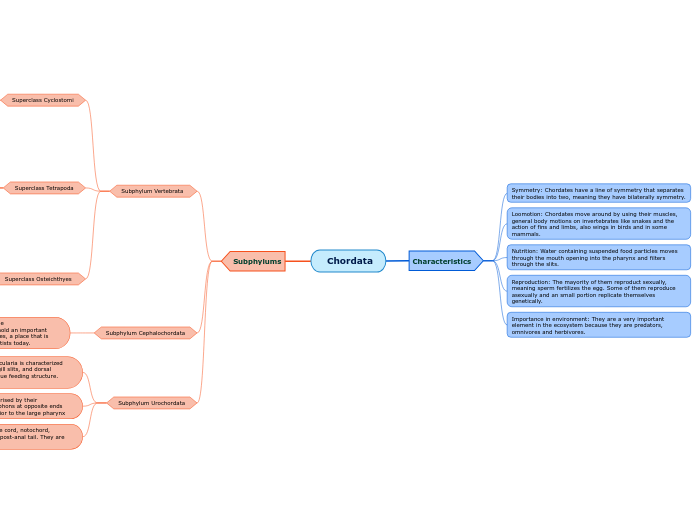Chordata
Subphylums
Subphylum Urochordata
Class Ascidiacea: A dorsal tubular nerve cord, notochord, rudimentary pharyngeal gill slits and a post-anal tail. They are non feeding animals
Class Thaliacea: Thaliacea are characterised by their translucent test, branchial and atrial siphons at opposite ends of the body and the atrial cavity posterior to the large pharynx
Class Appendicularia: The class Appendicularia is characterized by the persistence of a tail, notochord, gill slits, and dorsal nerve cord throughout life and by a unique feeding structure. they swim
Subphylum Cephalochordata
Class Leptocardi: Despite the small size of the cephalochordate subphylum, these animals hold an important place in the evolutionary history of vertebrates, a place that is still being characterized and defined by scientists today.
Subphylum Vertebrata
Superclass Osteichthyes
Class Actinopterygii: Generally lack choanae, no fleshy base to paired fins, no internal nares, air sacs usually function as swim bladder, skeleton usually well ossified.
Class Sarcopterygii: Muscular paired fleshy fins, fins attached the pelvic and pectoral girdle by single basal bone and teeth coated with enamel.
Superclass Tetrapoda
Class Amphibia: These can live both on land and in water.
They are ectothermic animals, found in a warm environment.
The skin is smooth and rough without any scales, but with glands that make it moist.
Class Reptilia: These are creeping and burrowing terrestrial animals with scales on their body. They are cold-blooded animals found in most of the warmer regions of the world. Their skin is dry, and rough, without any glands.
Class Mammalia: Mammals have hair or fur; are warm-blooded; most are born alive; the young are fed milk produced by the mother's mammary glands and they have a more complex brain than other animals.
Superclass Cyclostomi
Class Hyperoartia: Is a jawless fish and they do not have a true vertebral column
Class Myxini: The Myxini characteristic is that they lack vertebrae and only have a partial skull, making them not completely vertebrates.
Characteristics
Importance in environment: They are a very important element in the ecosystem because they are predators, omnivores and herbivores.
Reproduction: The mayority of them reproduct sexually, meaning sperm fertilizes the egg. Some of them reproduce asexually and an small portion replicate themselves genetically.
Nutrition: Water containing suspended food particles moves through the mouth opening into the pharynx and filters through the slits.
Loomotion: Chordates move around by using their muscles, general body motions on invertebrates like snakes and the action of fins and limbs, also wings in birds and in some mammals.
Symmetry: Chordates have a line of symmetry that separates their bodies into two, meaning they have bilaterally symmetry.

